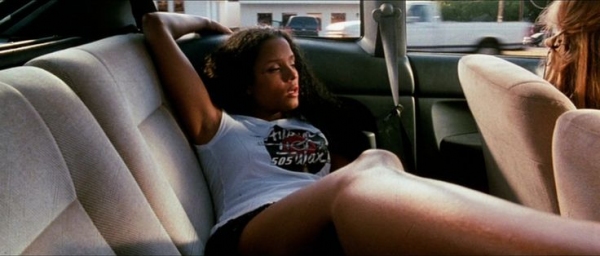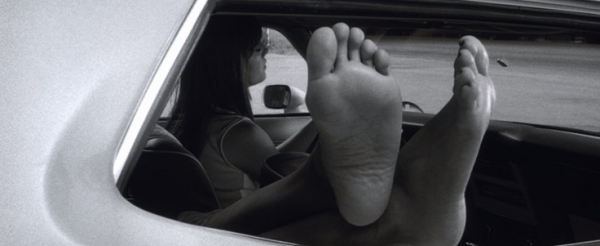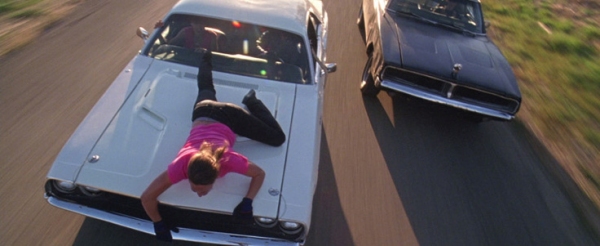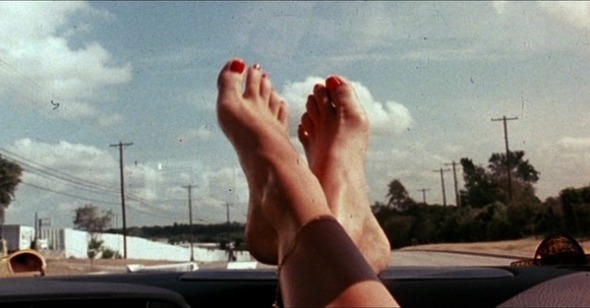Hold Tight
Michael Koresky on Death Proof
If you close your eyes and think of a Quentin Tarantino movie, you can practically see its shape. His films don’t progress in straight lines, but function as discrete story units that, when placed together, form an unforeseen yet strangely satisfying geometric whole. Pulp Fiction is a circle. Jackie Brown, with its three converging narratives, is a triangle. The Kill Bill saga a rectangular grid, five stories for each of the two films, stacked next to each other. Inglourious Basterds, told as though a series of at first blush unrelated short stories, is five consecutive, overlapping squares. Django Unchained is more amorphous, kind of like one misshapen oval flopped atop another. It all might sound silly to reduce films to such outlines, but Tarantino is such a precise filmmaker and dedicated storyteller that his elegantly planned out parallels, repetitions, and narrative matches create completely self-contained, preordained, and pleasing shapes.
Story creates the shape of these films, but Tarantino’s 2007 film Death Proof is all shape and no story. Its oddness—in texture, structure, narrative, and character—may account for its being the lowest-grossing, least discussed, and perhaps most misunderstood work in the director’s oeuvre. As with so many of his films, Death Proof functions as both a winking throwback to and a commentary on the genres and forms it fetishizes. With Jackie Brown it was Blaxploitation, Kill Bill a kung-fu/yakuza/anime mash-up, Inglourious the World War II action picture, Django the western. Death Proof takes the gear-shredding seventies car chase movie as its starting point, but what it really has on its mind is the even less reputable rape-revenge genre. Death Proof’s amalgamation of these two types of exploitation movie made a lot of sense in the film’s original context: the film was first released, in a much shorter version, as part of the double-bill experiment Grindhouse, Tarantino and Robert Rodriguez’s attempt to evoke the experience of watching decidedly non-prestige films in sticky-floored theaters during the seventies. But what may have seemed on first glance like just a feature-length gimmick is perhaps Tarantino’s purest, even most radical film, made up of a complex interplay of gazes and perspective shifts and whose narrative effectively functions as two mirrored halves gazing at one another.
In my mind’s eye, Death Proof looks like two long, narrow rectangles of near identical length lying side by side. To put it broadly: the first half of the film follows the lengthy stalking and killing of a group of attractive young women at the hands (or more accurately, steering wheel) of a maniac; the second involves the revenge meted out upon this same man by an entirely unrelated group of potential female victims, who have no knowledge of the murders we saw in the first part. Thus the climactic mission of vengeance undertaken by the second group of women becomes as grandiose and cosmic as it is literal: a universal retribution in which Woman slays Man for his continual violence against her. Seen this way, without the details and idiosyncrasies of character and environment that define Tarantino’s brand of American cinema, it makes sense for Death Proof to function better in outline than in specifics. There are of course characters—colorful ones, funny ones, vivacious and intelligent ones, nearly all of them women. But in Death Proof Tarantino is not above placing them into boxes, all the better to get us to see how he’s playing with the labels.
So if Death Proof is all about the outlines and perceptible forms of things, it makes sense that the shape of the screen itself would be as important as everything that goes in it. As far back as his first film, Reservoir Dogs, Tarantino has preferred the scope of 2.35:1, using it for all but Jackie Brown. It’s not difficult to see why a movie fetishist like Tarantino would prefer the extra-wide aspect ratio, as it’s the frame shape that most calls attention to itself: as an invention in the 1950s made to highlight cinema’s unique properties at a moment when the hopelessly square television format was spellbinding the nation, the dimensions of CinemaScope will forever be linked to the idea of theatrical invention and thus intrinsically a shape for spectacle. The predictably retro poster for Tarantino’s upcoming film, The Hateful Eight, which Tarantino has purported to be shooting on wide, high-resolution 70mm film, boasts a “Super CinemaScope” trademark. So even though in Grindhouse it marked a shift following Rodriguez’s 1.85:1 Planet Terror, Death Proof’s 2.35:1 width does not come as much of a surprise, even considering that the car pictures from the seventies that Tarantino’s film explicitly references (Vanishing Point, Dirty Mary Crazy Larry, White Line Fever) were shot in less ostentatious 1.85:1, a ratio that gives a little more of a sense of the vastness and verticality of the open road—of sky and sand, clouds and dust.
As it combines the open-air car-chase film with the claustrophobia of the stalker thriller, Death Proof is a more tightly contained variation on the road movie, like Monte Hellman’s laconic auto-fetish masterpiece Two-Lane Blacktop (also shot in 2.35:1, all the better to convey its characters’ cramped emotional isolation despite driving cross-country) combined with Bob Clark’s Black Christmas. The film’s anamorphic widescreen format, with its necessarily shallow depth of field, is perfectly suited to horror: potential threats lurk in the corners of the frame. The rationale for the extra-wide screen in Tarantino’s film goes beyond the generic or even symbolic. There’s something even pleasingly literal about it: one could say it offers the sleek dimensions of a sporty car, flat and wide like a Camaro, or one could say it mimics the expanse of a car’s windshield, as communicated in the opening credits, in which we see a woman’s bare feet resting on the dashboard of a car in motion. During this sequence, Tarantino cuts to another windshield, that of a decidedly more masculine car, bedecked with an aggressive hood ornament that cuts through the air as it plows through a back road: we’ve gone from the feminine to the masculine already, another of the film’s acute thematic splits. With the woman’s dainty toes center screen, the foregrounded width of the image, and the lovingly worn texture of the film itself—one of Grindhouse’s gimmicks was that it would look like a crummy old 35mm print unearthed from some dusty, ill-maintained archive—Death Proof is from its very first shot the ultimate Tarantino fetish film.
A different composition underlines all these elements: Sydney Poitier’s character, a stunning six-foot DJ with the objectifying professional name “Jungle Julia,” is sprawled out, in T-shirt and underwear, on a sofa beneath a huge portrait of another bombshell, Brigitte Bardot, also supine, the parallel positions of the two women anticipating the film’s structural mirror-image bifurcation. Poitier stretched in a lounging position, whether on a couch, in a car, or at a bar table, is a central visual motif in the film’s first half, which is rather drowsily paced to the rhythms of people biding their time—for reasons mundane or nefarious. In this opening, birthday girl Jungle Julia is waiting to be picked up by her girlfriends, Arlene (Vanessa Ferlito) and Shanna (Jordan Ladd); the three soon engage in the film’s first round of banter, in Shanna’s car, with Jungle Julia tucked away and lying down, naturally, in the back. The close quarters of the car’s interior, emphasized by the frame, initially reads as a safe space for the women, their own zone where they can talk freely and without judgment about the possibility of sex that night. Arlene and Shanna are sitting upright in the front seats, but all three are tight in the picture, hemmed in by the window frames, the first of many images of women within cars, spaces that alternately confine them and grant them freedom. (It’s clearly not a mere whim that Death Proof’s closing credits splice in archival images of the color-bar-holding “China Girls,” historically used by film-processing lab technicians for color calibration and the ultimate industrial example of a woman captured, silenced, and objectified on film.)

The women are en route to a night of Austin bar-crawling—first stop a taco bar for margaritas, then a dive called Warren’s—with no greater goal than to meet up with friends or maybe cute guys. There’s intentionally no urgency to the scenario, as Tarantino quickly establishes the parameters of a “hang-out movie,” a term he has applied to Rio Bravo, Dazed and Confused, and his own Jackie Brown. With so little seemingly at stake in terms of plot and character, we are left to luxuriate in what we are seeing rather than anticipating what comes next: the sinuous camera movements in and outside of the bar, from glowing warmth to blue, rainy menace; the way Jungle Julia’s massive mounds of kinky hair whip around in circles that touch either side of the expansive frame as she dances near the jukebox; the weirdly poignant exchange of texts between Jungle Julia and her absent honey, filmed and scored (to a morsel of Pino Donaggio’s aching Blow Out love theme) as though leafs from an epistolary romance for the ages.
Throughout this bar scene, Tarantino uses the wide frame to reiterate the simultaneous expanse and claustrophobia of the room. There’s a bristling sensuality to everyone’s movements. Tarantino, acting for the first time as his own cinematographer, is all but fondling the screen, apt for a film that’s not just voyeuristic but takes the concept of cinematic scopophilia as its starting point. The film firmly establishes that the women are being watched, and not only by us, in a shot from outside the taco bar; our villain, played by Kurt Russell, spies on them from inside his car, drenched in De Palma red. He has photos of all three women affixed to his sun visor. The women are now objects, the camera’s gaze matching up with this stalker’s; as Death Proof continues, this sense becomes increasingly heavy, the notion of being watched overlaying the film with a palpable yet free-floating suspense.
The watcher turns out to be Stuntman Mike, so folksy and seemingly gentle, despite the deep-grooved scar cutting down the side of his face, that we cannot believe he would do any real harm. We first get a close look at him as he digs his slippery fingers into a plate of oily bar nachos, sporting an anachronistic silver-gray racer’s jacket with an IcyHot patch and wearing an avuncular grin as he knocks back club sodas and virgin Piña Coladas. Via his conversation with Pam (Rose McGowan), a bored vixen a few stools down, we learn some basic information about him, such as that he’s a teetotaler and a former movie stuntman. Nearby, a couple of horny creeps, played by Eli Roth and Michael Bacall, are trying to figure out how to liquor up our girls and take them home, which only puts in sharper relief Stuntman Mike’s relatively benign quality. Sex is in the air, but he seems to want something else. That something appears to be Jungle Julia and her friends, whom he gazes at from across the bar with a warm regard that feels more paternal than necessarily erotic. His well-honed nice-guy charm, is, of course, a ruse. As we soon learn, he’s a red-blooded movie maniac, a single-minded machine of driven male lust, whose violent sexual urges only find release behind the wheel of his souped-up 1971 Chevy Nova, which he has reinforced to be “death proof” for the driver. It’s like a homicidal B-movie riff on David Cronenberg’s Crash as well as a knowing, feature-length extrapolation of the tired joke of a man’s car compensating for his modest member.
At one point, Stuntman Mike gets up the courage to talk to the intimidating Jungle Julia, but is thwarted when he begins to sneeze, can’t quite get it out, and frustratedly walks away—a perfection encapsulation of what the film is thus far all about: catharsis deferred. After nearly an hour of screen time, all this foreplay—the waiting, the flirting, the teasing—culminates in two quick bursts of shocking violence: the first against Pam, who after unfortunately requesting a ride home, ends up an unwitting test dummy in the passenger-side crash box of Stuntman Mike’s battering ram of a Chevy; the second against Jungle Julia, Arlene, Shanna, and a designated driver friend taking them home from the bar. To the foot-stomping pop strains of Dave Dee, Dozy, Beaky, Mick & Tich’s “Hold Tight,” he intentionally plows straight into the front of their car at full speed, ripping through metal, glass, flesh, and bone with such terrifying, exhilarating speed that Tarantino, with the help of his brilliant late editor Sally Menke, shows it four times in quick succession so we can get a hang of what’s going on spatially. Like the fourth chapter in Inglourious Basterds, set in the basement of a German tavern, Tarantino has given the viewer a long, languorous set-up followed by a quick ejaculate of blood, the rush of violence as satisfying as it is repulsive.
During these first fifty minutes, the image occasionally skips past missing frames, the soundtrack at times pops and cracks, and there are visible scratches, as well as instances of burn, wear, and tear. Like a pre-distressed ball cap, the film—the texture—has been manipulated to look as though it’s from an earlier era. But the film as we experience it doesn’t move or talk like an older film. It clearly isn’t set in the past (the only sign that it’s contemporary is Jungle Julia’s strategically used cell phone), but this first half is, as will become clear, the “old”—or at least outmoded—movie. After a quick bridging sequence, set in the hospital where Stuntman Mike is recovering from minor wounds (and where a local sheriff admits he knows it’s vehicular homicide but won’t do anything about it), we get to the “new” movie, a film scrubbed of these kinds of lacerations and hiccups, and empowered by a new group of women who refuse to be victimized—by Stuntman Mike or by the camera itself.
*****
There’s an extended transitional scene at the beginning of the second half of the film—and which was deleted from the shorter Grindhouse cut of the film—that’s worth going into in some detail for the way it visually signals a crucial shift of perspective. It’s fourteen months later, and we’re in Lebanon, Tennessee. Stuntman Mike, now driving a Dodge Charger, affixed with the same hood ornament as his now totaled Chevy, pulls into a convenience store driveway. We see the usual scratches and marks across the screen, but then the image suddenly shifts, as though a button has been pushed, into pristine black-and-white; from this point on the film no longer looks like it was spliced on a Steenbeck and neglected in an ill-maintained archive for thirty-five years.

Stuntman Mike has scoped out a new group of potential victims, Abernathy (Rosario Dawson), Kim (Tracie Thoms), and Lee (Mary Elizabeth Winstead), who appear to be having some serious afternoon downtime while parked in front of the store with their 1972 Ford Mustang. Abernathy, like Jungle Julia before her, is stretched out in the back seat, one foot sticking out the window; after a moment of silent flirtation—he walks past her and discreetly tickles her bare sole—Stuntman Mike gets back in his car and exits the lot. Abernathy awakes from her slumber, moves to the hood of the car and sits down facing the camera, slips on her boots, lights a cigarette, scans the horizon. The shot goes on for forty-five silent seconds. There’s no music, just the sounds of cars rushing by. Suddenly, a cut to the Dodge parked across the street, like the cop who drove Janet Leigh crazy with paranoia in Psycho. He has been watching her right along with us. She notices the car before it screeches off, leaving her finally alone. Once the last aural remnants of his presence have completely faded into the distance, the image transitions to color: the Mustang now a perfectly bright bumblebee yellow, Dawson’s unicorn t-shirt a dazzling cake-frosting pink. Lee’s cheerleader outfit is cleanly pressed and as perfectly yellow as the Mustang, and inside the store there are rows of eye-pleasingly colored soda pop and magazines (including, improbably and affectionately, an issue of Film Comment). Though it maintains the 2.35:1 width of the frame, everything else about the picture has shifted. It’s the same film, but there’s now a clarity to the image. We have officially entered a new world, one that reads as bright, feminine, and clear-headed; Stuntman Mike’s movie is finished. The remainder of Death Proof belongs to the women.
Less abstracted and with more forward momentum than the first half, this section of the film establishes the twinned genres (car chase and rape-revenge) only previously hinted at. If Death Proof starts out as a pop exegesis on the male orgasm, it ends up as a movie about female pleasure. Abernathy, Kim, and Lee meet up with a fourth friend, Zoe (Zoe Bell), who, like Kim is a movie stuntwoman (as is Bell, in reality); Abernathy and Lee are a makeup artist and a model-actress, and all are in middle-of-nowhere Lebanon working on a movie shoot. In their first scene all together, the four women are snug within the elongated, thin frame, ensconced inside the Mustang, which is all bright red leather, connoting at once womblike safety and looming danger. Then, in an elegant single take circling around the women while gabbing at a café table (seemingly riffing off of a similar scene in Hannah and Her Sisters), Tarantino uses the frame to capture a wide array of nuance from all his actors, ingeniously and swiftly establishing the broad character strokes and specific plot points we need for the rest of the movie to make sense: Kim and Zoe are self-proclaimed “gearheads” who revere car-chase movies, while Abernathy and Lee prefer John Hughes classics; fearless Zoe can fall into a forty-foot ditch, pick herself up, brush herself off, and start all over again; Kim carries a gun. When asked why she does this, Kim says it’s because she doesn’t want to get raped if she chooses to do her laundry at midnight. Lee suggests she shouldn’t do her laundry at midnight. Kim’s response: “Fuck that, I’m gonna do my laundry whenever I want to do my laundry.”
This is crucial: Death Proof, via its extended climactic action sequence, will metaphorically interrogate the specious argument that a raped woman can be at all blamed for her own victimization by virtue of putting herself in harm’s way—whether it’s by doing her laundry at midnight, wearing provocative clothes, or in this film’s case, playing daredevil stunts while test-driving a used 1970 Dodge Challenger with a 440 engine (the same model as in Vanishing Point, of course). It’s Zoe’s desire to play “Ship’s Mast” on this kick-ass car’s roof—clinging to belt straps while Kim drives at full speed down a mostly deserted Tennessee country highway—that attracts the attention of the homicidal Stuntman Mike, who appears from behind, ramming and swerving into the Challenger to dislodge Zoe and send her flying, all the while screaming sexual taunts (“You wanna get hot? Suck on this for a while”). After a terrifying high-speed chase that leaves Zoe a little dusty but no worse for the wear, the women turn the tables, making Stuntman Mike their bloody prey.

Tarantino expertly utilizes the screen’s narrow borders to limit our vision as he captures these pursuits throughout the otherwise peaceful rural Southern back roads. There isn’t verticality within these frames, which makes the elegant lateral movements of their speeding cars all the more thrilling to watch. In a visceral view from Stuntman Mike’s driver’s side window, the Charger sidelines the Challenger in one smooth veer, the two cars whipping down the highway with gorgeous symmetry, which is all the more apparent from the way the Dodges’ shapes mimic the wide frame and are snugly contained within it. It’s another example of how much Tarantino prefers evenness and balance, even in seemingly chaotic situations (check out the geometric precision of the climactic yakuza swordfights in Kill Bill Vol. 1, which offer the pleasant feel of choreographed dance more than the shock of random carnage).
Death Proof concludes on a moment of triumph: the women have turned the tables on their attempted killer, kicking and punching the shit—and effectively, the life—out of him. In an image that underscores their freedom, Abernathy, Zoe, and Kim, having caught up with their prey, exact their final punishment on the open road. They have left the confines of the now trashed car and are standing upright as they reduce Stuntman Mike to a mewling, blood-and-tear-stained mess of a man. The revenge itself doesn’t feel like a moment of brutality as much as a spiritual release. He ends up flat on the ground; the women are standing all around him, their arms raised straight up in triumph, creating the film’s first truly vertical composition.
Death Proof played Friday, March 13, 2015 at the Museum of the Moving Image as part of See it Big! High and Wide, a series co-programmed by Reverse Shot and Museum of the Moving Image.
